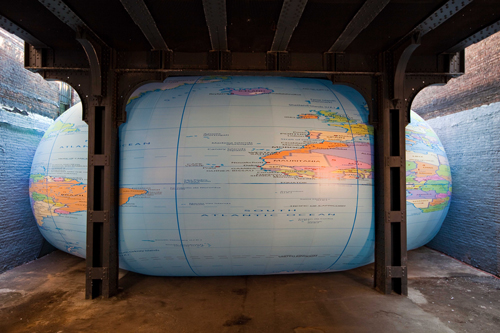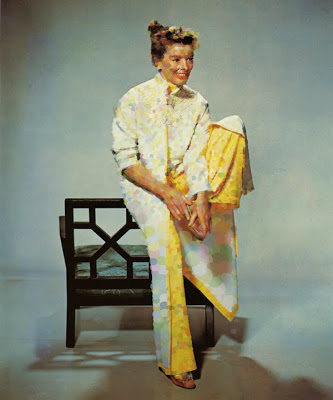Burning Down Byrne
 On October 7, 2014, David Byrne the modern day Renaissance man and ex-Talking Heads lead, posted a blog entry on his website “I DON’T CARE ABOUT CONTEMPORARY ART ANYMORE?” The commentary, a seeming impromptu riff on his reaction to the current state of contemporary art, has garnered a lot of attention. Byrne isn’t just a painter and musician, he’s currently partnered with one of the art stars of the 1980’s, Cindy Sherman. His position, therefore, provides him with unusual access from both the point of celebrity and art world insider, to the undercurrent of New York’s art market. So, when Byrne writes about the art world he is writing from a position of art and financial power as well as a practitioner.
On October 7, 2014, David Byrne the modern day Renaissance man and ex-Talking Heads lead, posted a blog entry on his website “I DON’T CARE ABOUT CONTEMPORARY ART ANYMORE?” The commentary, a seeming impromptu riff on his reaction to the current state of contemporary art, has garnered a lot of attention. Byrne isn’t just a painter and musician, he’s currently partnered with one of the art stars of the 1980’s, Cindy Sherman. His position, therefore, provides him with unusual access from both the point of celebrity and art world insider, to the undercurrent of New York’s art market. So, when Byrne writes about the art world he is writing from a position of art and financial power as well as a practitioner.
A few days later the artist and former gallerist, Ric Kasini Kadour wrote on Hyperallergic a counterpoint screed which attacked Byrne directly; “I Don’t Care About David Byrne Anymore?” A sideline memetic reaction has been taking place on everyone’s favorite social media platform Facebook. Aside from Kadour’s somewhat vitriolic retort (“Boo hoo, fuck off.”), I think both Kadour and Byrne miss the mark in their commentary about the state of contemporary art and strangely find themselves closer in alignment than either might admit.
First of all, contemporary art is not class warfare as many would like to pretend it is. As the late Robert Hughes so eloquently put it, “In art there is no progress, only fluctuations of intensity.” Capitalism by nature is predicated on constant progress and consumption, whether perceived or real. Art doesn’t play by those rules, which is exactly what makes it desirable to the 1%. What the extremely wealthy can’t have, they must have. This doesn’t pollute the art world per se, but only becomes more recognizable, more obvious in times of, as Hughes puts it, fluctuating intensity. Right now contemporary art is experiencing a period of low intensity, as is music. There may be a lot of people out there making things but there is no current collective zeitgeist to grab hold of and that makes for a lot recirculation of the old, the average, and the bad. Artists have always and will always pander to rich collectors because money makes the world go round and despite protests to the contrary, being a starving artist sucks. In order for art market to operate as class warfare it would have to persistently deny future Basquiats or present day Sam Falls, but it doesn’t. It may be dictated by tastemakers who see dollar signs but it doesn’t discriminate based on class. For this very reason, it keeps a perpetual flow of young, fresh MFA graduates hungry for success and fully participating in the system that fuels the amusement of the 1%.
Secondly, Byrne and Kadour both use straw man arguments to make their points. It is so easy to pick on the richest artist in the world, Damien Hirst and his For the Love of God (2007) diamond skull. Hirst is an opportunist more than a real artist and the bulk of his production is either a direct or near direct rip-off of other more talented artist’s work. So what. He is one man in a very large pool of makers and one man does not the art market make. Hating on Jeff Koons or Damian Hirst does little to add to the conversation on contemporary art. In equal measure, Kadour’s naive references to what might be termed ‘working class artists’ of various ilk is no better a position against the great art market engine. Just because you make something doesn’t mean you’re adding anything to the collective cultural conversation, especially didactic, playful sculptures of robots. Great art as we all know, penetrates deeply into the collective subconscious and communicates some form of undefinable knowledge that changes how we inhabit the world and bridges race, class and culture. The fact that there is little great art being made now may be lamentable but blaming it on economic conditions, secret gallery cabals or David Byrne himself, seems silly at best.
I understand Byrne’s disappointment as much as I get Kadour’s anger at Byrne and the art world. How many artists were of equal or superior measure to Vermeer or Titian in their time but lacked middle class upbringings or support from the church? Nobody ever said the art market or life was fair. I don’t believe that money pollutes the water of art production, there are just too many examples of great artists who found their power outside of the art market or wealthy patronage to convince me otherwise. Likewise I’m tired of the old 1960’s argument that by virtue of your own wealth or lack there of, you can’t comment on certain cultural conditions because you are either in or out of the “club.” Byrne paid his dues and couldn’t have possibly predicted his rise to wealth by way of an incredibly strange art-rock group that emerged in the late 1970’s and early 1980’s. Saying he’s rich so therefore he can’t comment on the rich is absurd. If anything, there is potential for him to reveal things that others would not ever have access to. By the same token, Kadour’s middle-class status, or at least non-wealthy status, isn’t an automatic pulpit for criticism either. The answer to contemporary art’s dilemma is not a socialist equalizing one. History teaches us that art often blossoms during conditions of inequality more than its opposite and therefore cannot be constrained or defined by economics or politics alone. Kadour regurgitates a lazy and tired argument that implies that if only less rich people were involved the art market would be more fair, and by association, better. Nothing could be further from reality.
Byrne’s comparison of the Dutch tulip bubble or Tulpenwoede is an apt one that Kadour completely glosses over. As someone who has spent a lot of time in working class artists studios, smaller more provincial galleries (like the Portland, Oregon gallery Kadour mentions—I live in Portland) I can tell you I have yet to see a great hidden, seething mass of talent. Bryne is right that the art market is paralleling the current economic conditions. Art has always been a profitable investment, out earning the stock market with regularity. It’s experiencing a bubble and with bubbles come breaks and then something interesting usually happens.
The real danger we face in the art world is the institutionalization of art production. Every year there are over 1,200 applicants for the MFA program at Yale. Yet, the percentage of employment of arts-related graduates has steadily declined since the 1970’s. The number of students receiving a bachelors degree in fine art in the U.S. has gone up 25% in nine years. In 2010 there were 29,000 graduates in art related fields. That’s 300,000 degreed people calling themselves artists in a ten year span. With tuition having risen at such rapid rates over the past three decades it is no wonder we have such simmering anger amongst young artists. There are simply too many artists who carry too much college debt to ever be equalized by even the most economically balanced art market. Combine this with the fact that the overwhelming majority of Americans never set foot during their lifetime in a commercial art gallery, despite millions attending art museums and you begin to see the dilemma. Art production is equated with laziness and frivolity in America and paying for such things is considered the folly of the rich. Why would you ever spend $1,000 for a work of art when you can endlessly listen to the new Beyonce album for a mere $15.99?
Until we change the underlying dynamics of how artists learn to practice their craft, how they form a professional practice while holding down a full time job and how they can create collectively owned gallery spaces that establish themselves in the suburbs and lower income communities, using micro payments and shared economic models, nothing will change in the art market of America and likely little will happen to create the conditions for the next generation of great artists.

